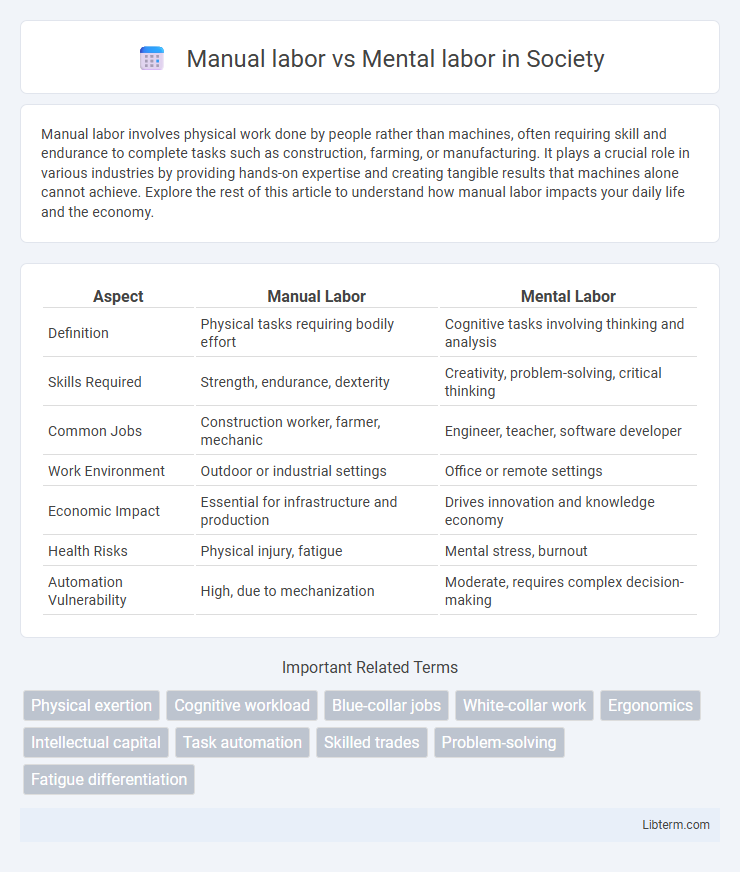Manual labor involves physical work done by people rather than machines, often requiring skill and endurance to complete tasks such as construction, farming, or manufacturing. It plays a crucial role in various industries by providing hands-on expertise and creating tangible results that machines alone cannot achieve. Explore the rest of this article to understand how manual labor impacts your daily life and the economy.
Table of Comparison
| Aspect | Manual Labor | Mental Labor |
|---|---|---|
| Definition | Physical tasks requiring bodily effort | Cognitive tasks involving thinking and analysis |
| Skills Required | Strength, endurance, dexterity | Creativity, problem-solving, critical thinking |
| Common Jobs | Construction worker, farmer, mechanic | Engineer, teacher, software developer |
| Work Environment | Outdoor or industrial settings | Office or remote settings |
| Economic Impact | Essential for infrastructure and production | Drives innovation and knowledge economy |
| Health Risks | Physical injury, fatigue | Mental stress, burnout |
| Automation Vulnerability | High, due to mechanization | Moderate, requires complex decision-making |
Introduction to Manual and Mental Labor
Manual labor involves physical tasks that require bodily strength and dexterity, commonly seen in construction, manufacturing, and agriculture. Mental labor focuses on cognitive processes such as problem-solving, analysis, and decision-making, typical in fields like research, IT, and management. Both types of labor are essential for economic productivity and often complement each other in various industries.
Historical Evolution of Labor Types
Manual labor, rooted in agricultural and artisanal societies, predominated until the Industrial Revolution introduced machinery that reshaped labor demands, shifting many tasks from physical to mechanized processes. The 20th century's rise of the service and information economies propelled mental labor, characterized by cognitive skills and technological proficiency, to the forefront of employment sectors. This historical evolution highlights the transition from predominantly manual labor in pre-industrial times to an emphasis on mental labor in contemporary economies driven by innovation and knowledge work.
Defining Manual Labor: Characteristics and Examples
Manual labor involves physical work that requires bodily strength and dexterity, commonly seen in occupations such as construction, farming, and manufacturing. It is characterized by repetitive tasks, use of tools or machinery, and the performance of skilled or unskilled physical activities. This type of labor contrasts with mental labor, which primarily engages cognitive skills, problem-solving, and decision-making processes.
Understanding Mental Labor: Key Features and Roles
Mental labor involves cognitive processes such as problem-solving, decision-making, planning, and emotional regulation, essential for managing complex tasks and leadership roles. Key features include sustained concentration, multitasking, information synthesis, and anticipating future challenges, often demanding high levels of creativity and strategic thinking. This type of labor plays a crucial role in innovation, organizational efficiency, and adapting to dynamic environments, distinguishing it significantly from physical manual labor.
Skill Sets Required for Manual vs. Mental Labor
Manual labor primarily requires physical strength, dexterity, and endurance, along with specialized skills such as tool handling, machinery operation, and precision in repetitive tasks. Mental labor demands cognitive abilities including critical thinking, problem-solving, creativity, and expertise in information processing, analysis, and decision-making. Both types of labor necessitate focused training and experience, but manual labor leans on physical coordination and stamina while mental labor depends on intellectual capacity and advanced knowledge.
Economic Value and Societal Perception
Manual labor often faces lower economic valuation compared to mental labor, despite its critical role in sectors like construction and agriculture. Mental labor, prevalent in knowledge-based industries, typically commands higher wages and greater social prestige due to its association with creativity, problem-solving, and decision-making skills. Societal perception frequently undervalues manual labor's contribution to economic stability, reinforcing wage disparities and influencing career aspirations.
Physical and Psychological Impacts on Workers
Manual labor often results in significant physical strain, including musculoskeletal injuries and chronic fatigue, while mental labor predominantly causes psychological stress, anxiety, and cognitive overload. Workers engaged in physical tasks face repetitive motion injuries and long-term wear on the body, whereas those performing cognitive tasks experience mental exhaustion and burnout due to sustained concentration demands. Understanding the distinct health impacts on manual versus mental labor can inform workplace ergonomics and mental health support strategies to optimize worker wellbeing.
Technological Advancements and Their Influence
Technological advancements have significantly transformed both manual and mental labor by automating repetitive physical tasks and enhancing cognitive processes through artificial intelligence and machine learning. Automation and robotics reduce the demand for manual labor in manufacturing and agriculture, while digital tools and data analytics increase productivity and decision-making efficiency in mental labor sectors. These innovations redefine skill requirements, pushing workers towards higher specialization and continuous learning in both physical and intellectual domains.
Gender Dynamics in Labor Distribution
Gender dynamics in labor distribution reveal persistent patterns where manual labor is often associated with men, while mental labor disproportionately falls on women, especially in household and caregiving contexts. Studies show women contribute significantly to unpaid mental labor, including organizing, planning, and emotional management, despite participating less in physically demanding tasks. This imbalance reinforces traditional gender roles and affects economic opportunities and work-life balance for both men and women.
The Future of Work: Bridging Manual and Mental Labor
The future of work requires integrating manual labor and mental labor through advanced technologies like automation and artificial intelligence, enhancing productivity and job satisfaction. Hybrid roles that blend physical tasks with cognitive skills are emerging, creating opportunities for reskilling and workforce adaptability. Emphasizing lifelong learning and digital literacy enables workers to thrive in evolving labor markets, bridging traditional divides.
Manual labor Infographic

 libterm.com
libterm.com